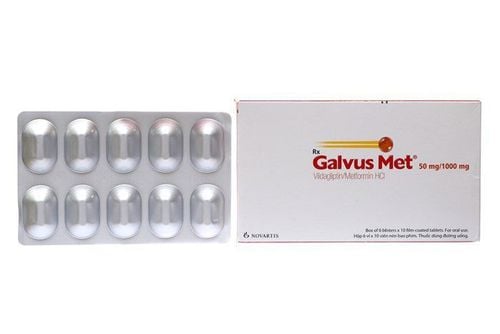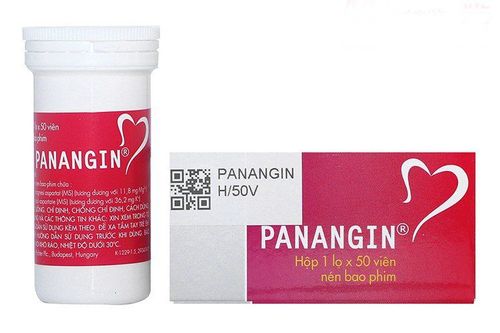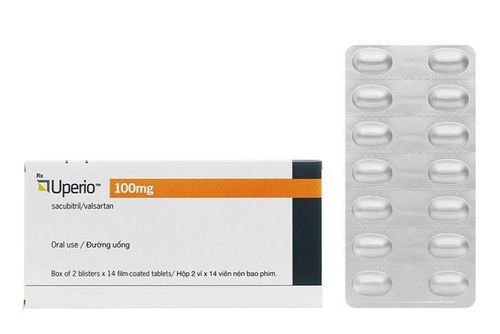Betaloc 50mg is used to treat high blood pressure and rapid heart rhythms, but it has many contraindications such as severe asthma, heart failure, etc. Learn about the side effects of Betaloc 50mg in the article below.
1. Effects of Betaloc 50 mg
1.1. What is Betaloc 50mg?
Betaloc 50mg is a product of AstraZeneca Pharmaceutical Co., Ltd. (UK), containing Metoprolol as its active ingredient, a beta-blocker. The medication is formulated in tablet form with a dosage of 50 mg.
1.2. What is the effect of Betaloc 50mg?
Betaloc 50mg is prescribed by doctors for the following conditions:
- Treatment of high blood pressure: Helps reduce blood pressure, decrease the incidence of acute hypertension, and minimize the risk of death due to cardiovascular diseases and coronary artery diseases (including sudden death).
- Prevention of angina attacks: Reduces the frequency and severity of chest pain caused by angina.
- Treatment of certain types of arrhythmias: Including ventricular tachycardia (tachycardia, paroxysmal tachycardia) and supraventricular tachycardia (atrial fibrillation, atrial flutter, or junctional tachycardia).
- Post-myocardial infarction maintenance therapy: Helps maintain heart function after a stable heart attack.
- Heart failure support: Assists in managing heart failure.
- Treatment of irregular heart function with palpitations.
1.2.1. In the treatment of high blood pressure (hypertension)
Betaloc 50mg belongs to a class of drugs called long-acting beta-blockers. It slows your heart rate and helps your heart pump with less force. This reduces your blood pressure and helps lower the risk of stroke, heart attack, other heart problems, or kidney issues in the future. The medication needs to be taken regularly to be effective, so continue using it even if you feel fine. Do not stop taking it without consulting your doctor.
1.2.2. In the treatment of angina (chest pain related to the heart)
Betaloc 50mg helps relax the blood vessels so that blood can flow more easily around your body, ensuring that your heart gets enough oxygen. This reduces the likelihood of chest pain from angina. Betaloc may also improve your ability to exercise and carry out daily activities by decreasing the frequency of angina attacks. You should take it regularly under your doctor's supervision to ensure its effectiveness.
1.2.3. In the treatment of arrhythmia
Betaloc 50mg helps stabilize your heart rate (especially in atrial fibrillation). It helps normalize abnormal heart rhythms, prevent them from occurring in the first place, or slow down the heart rate during an episode.
1.2.4. For prevention of heart attacks
Betaloc 50mg helps reduce blood pressure and aids the heart in pumping blood more easily throughout your body. This reduces your risk of having a heart attack. It may also lower the risk of death if administered immediately after a heart attack. Betaloc should be taken regularly to achieve results, so continue using it even if you feel fine. Do not stop taking it without consulting your doctor.
1.2.5. For the prevention of migraines
Betaloc 50mg alters electrical activity in the brain, reducing blood flow in your brain or increasing activity in a region related to migraines. By preventing and reducing the frequency of migraines, it can help you carry out daily activities and improve your quality of life.
2. How to use Betaloc 50mg
2.1. How to take Betaloc 50mg
Swallow the tablet whole, without crushing or mixing it with other substances. Take it with or immediately after a meal, as taking it with food increases the drug's bioavailability.
2.2. Recommended dosages
2.2.1Hypertension:
The recommended dose for hypertension is 100 to 200 mg per day, divided into two doses in the morning and evening. If necessary, your doctor may increase the dose or combine it with other antihypertensive drugs from different classes.
Long-term hypertension treatment with Betaloc 50 at a daily dose of 100 to 200 mg has been shown to reduce the mortality rate in patients, including deaths from stroke, cardiovascular events, and coronary artery incidents in patients with hypertension.
2.2.2 Angina prevention: The recommended dose is 100 to 200 mg per day, divided into two doses in the morning and evening. It may be combined with other anti-anginal drugs.
2.2.3 Arrhythmia: The recommended dose is 100 to 200 mg per day, divided into two doses in the morning and evening. It can be combined with other anti-arrhythmic drugs if necessary.
2.2.4 Post-myocardial infarction maintenance: Long-term treatment with Betaloc at a dose of 200 mg per day, divided into two doses, has shown to reduce the risk of death (including sudden death) and reduce the risk of reinfarction (including in patients with diabetes).
2.2.5 Heart dysfunction with palpitations: The recommended dose is 100 mg per day, taken once in the morning. The dose may be increased to 200 mg if needed.
2.2.6 Heart failure:
- For stage II heart failure: Start with half a tablet once daily for 2 weeks, then increase to one tablet daily for 2 weeks, then double the dose to reach a maximum of 4 tablets per dose.
- For stage III or IV heart failure: Start with 1/4 tablet once daily, gradually increasing the dose as described.
2.2.7 Liver dysfunction: No dosage adjustment is necessary for patients with cirrhosis, as Metoprolol binds weakly to plasma proteins (5-10%). Dose reduction should be considered for patients with severe liver dysfunction (e.g., with a shunt).
2.2.8 Kidney dysfunction and elderly patients: No dosage adjustment is required.
2.3. Overdose
Overdose management should take place in a medical facility with proper supportive equipment for monitoring and care.
If appropriate, gastric lavage and/or activated charcoal may be used. Atropine, sympathomimetic drugs, or pacemakers may be used for bradycardia and conduction disorders.
Intubation and mechanical ventilation should be done with a broad indication. Pacemaker use should be determined on a case-by-case basis.In case of circulatory collapse due to overdose, resuscitation measures may save the patient within a few hours.
Hypotension, acute heart failure, and shock can be treated with appropriate fluid volume expansion, glucagon (if necessary, intravenous glucagon), sympathetic drugs like Dobutamine, and α1 receptor agonists in case of vasodilation. Calcium ion solution may also be considered for intravenous injection.
Symptomatic treatment for bronchospasm should include bronchodilators.
3. Contraindications
- Severe asthma and severe chronic obstructive pulmonary disease (COPD).
- Uncontrolled heart failure.
- Cardiogenic shock.
- Second or third-degree AV block.
- Prinzmetal's angina (both simple and monotherapy forms).
- Sick sinus syndrome (including sinus node block).
- Bradycardia (< 45 - 50 beats per minute).
- Severe Raynaud's phenomenon and severe peripheral artery disease.
- Untreated pheochromocytoma.
- Hypotension.
- Hypersensitivity to Metoprolol.
- History of anaphylaxis.
- Not recommended for breastfeeding women.
4. Precautions when using Betaloc 50mg
- Do not suddenly stop the medication in patients with angina: Abrupt discontinuation may lead to myocardial infarction, severe arrhythmias, or sudden death.
- Contains Lactose: Patients with rare hereditary conditions such as Lapp lactase deficiency, galactose intolerance, or glucose-galactose malabsorption should not use Betaloc.
- Avoid using this medication in combination with Fingolimod, Diltiazem, Verapamil, or during breastfeeding.
- Avoid abrupt discontinuation, especially in patients with ischemic heart disease. The dose should be gradually reduced over one to two weeks. During this period, alternative treatments should be started (if necessary) to prevent worsening angina.
- For patients with asthma or chronic obstructive pulmonary disease (COPD): Beta-blockers should only be used in mild cases and with selective beta-1 blockers at a low starting dose. Respiratory function tests should be conducted before starting treatment. If severe asthma attacks or acute COPD exacerbations occur during treatment, beta-agonists may be used.
- For heart failure patients: In patients with controlled heart failure, Metoprolol can be used with gradual dose increases under close medical supervision.
- For patients with bradycardia: Reduce the dose if the resting heart rate is <50-55 beats per minute, and the patient shows symptoms of bradycardia.
- For patients with first-degree atrioventricular block: Caution is required when using beta-blockers in these patients because they can decrease the conduction velocity at the atrioventricular node.
- For patients with Prinzmetal's angina: Beta-blockers may increase the frequency and duration of angina attacks in patients with Prinzmetal's angina. In small doses and combination therapy, selective beta-1 blockers can be used along with a vasodilator.
- For peripheral arterial disease: In patients with peripheral artery disorders (e.g., Raynaud's phenomenon, arteritis, or chronic lower limb arterial occlusion), beta-blockers can exacerbate these conditions. In such cases, selective beta-1 blockers with partial agonist activity should be used cautiously.
- For patients with pheochromocytoma: Blood pressure should be carefully monitored when using beta-blockers for hypertension treatment in pheochromocytoma patients.
- For elderly patients: Strictly adhere to contraindications. Start treatment with a low dose and ensure tight monitoring.
- For patients with liver dysfunction: There is no pharmacokinetic data for Metoprolol in patients with liver disease or chronic kidney failure. Careful dose adjustment is required in these patients.
- For patients with cirrhosis: The bioavailability of Metoprolol may increase due to reduced clearance. In practice, the heart rate will be monitored and the dose should be reduced if bradycardia occurs (<50-55 beats per minute at rest).
- For patients with diabetes: Patients should monitor their blood sugar to prevent and maintain early-stage blood sugar control during treatment. Symptoms of hypoglycemia such as tachycardia, anxiety, and sweating may be masked.
- For patients with psoriasis: Caution should be exercised when prescribing this medication to patients with psoriasis.
- For patients with allergic reactions: In patients at risk for severe anaphylactic reactions, especially when using Floctafenine or during desensitization treatment, beta-blockers may worsen anaphylactic reactions and cause resistance to standard doses of epinephrine.
- General anesthesia: Beta-blockers reduce reflex tachycardia and increase the risk of hypotension. Continuing beta-blocker therapy decreases the risk of arrhythmias, myocardial ischemia, and hypertension. Patients should inform the anesthesiologist about the use of beta-blockers. If discontinuation of Metoprolol is necessary, stopping it 48 hours prior to anesthesia is usually enough to restore catecholamine sensitivity.
- Do not abruptly stop beta-blocker therapy in the following cases:
- Severe coronary artery disease: Continue treatment until surgery as there is a risk when stopping beta-blockers abruptly.
- In emergency situations or when discontinuation is not possible: To protect the patient from vagal control, Atropine should be administered during pre-comatose states if necessary. During anesthesia, the use of heart-rate-lowering drugs should be minimized and blood loss should be replaced.
- Consider the risks of hypersensitivity reactions.
- Avoid starting Metoprolol therapy for patients undergoing non-cardiac surgery.
- Doping test positive: The active ingredients in this medication may cause a positive result in doping tests. Athletes should be aware of this.
5. Side effects of Betaloc 50mg
Common:
- Cardiovascular: Postural disorders, slow heart rate, cold hands and feet, and palpitations.
- Central Nervous System: Dizziness, fatigue, headache.
- Respiratory: Shortness of breath on exertion.
- Gastrointestinal: Abdominal pain, nausea, diarrhea, constipation.
Uncommon:
- Cardiovascular: First-degree atrioventricular block, edema, transient worsening symptoms of heart failure, chest pain.
- Central Nervous System: Paresthesia, muscle cramps.
- Psychiatric: Lack of concentration, drowsiness or insomnia, nightmares, potential for depression.
- Respiratory: Bronchospasm.
- Gastrointestinal: Vomiting.
- Metabolism: Weight gain.
- Skin: Rash (urticaria, psoriasis-like lesions, and skin dystrophy), increased sweating.
Rare:
- Cardiovascular: Cardiac conduction disturbances, arrhythmias. Very rare: Necrosis in patients with pre-existing severe peripheral circulation disorders.
- Psychiatric: Restlessness, anxiety, sexual dysfunction/impotence. Very rare: Memory loss, cognitive decline, confusion, hallucinations.
- Respiratory: Rhinitis.
- Liver: Abnormal liver function tests. Very rare: Hepatitis.
- Musculoskeletal: Joint pain.
- Sensory: Visual disturbances, difficulty and/or irritation of the eyes, conjunctivitis. Very rare: Tinnitus, taste disorders.
- Skin: Hair loss, photosensitivity, increased psoriasis symptoms.
6. Storage of Betaloc 50mg
Store at a temperature of 30°C in a cool and dry place. Keep out of the reach of children.
Betaloc 50 is a medication used for treating hypertension, angina, and myocardial infarction in adults. Betaloc should only be used under the prescription of a doctor. Do not self-prescribe or use it without medical advice to avoid adverse health effects. During use, patients should carefully learn about Betaloc, its uses, and how to take it for effective treatment. If any unusual symptoms occur, immediately contact a specialist for advice.
To arrange an appointment, please call HOTLINE or make your reservation directly HERE. You may also download the MyVinmec app to schedule appointments faster and manage your reservations more conveniently.
To arrange an appointment, please call HOTLINE or make your reservation directly HERE. You may also download the MyVinmec app to schedule appointments faster and manage your reservations more conveniently.








